Cubic Zirconia (CZ): The Complete Guide to Diamond Alternatives

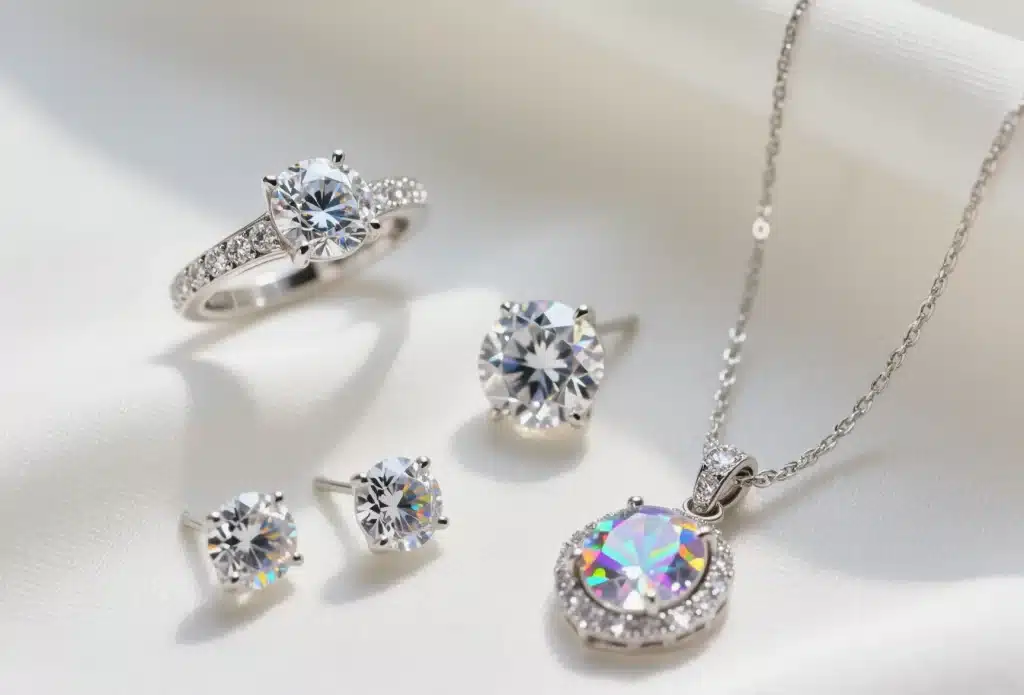
Key Takeaways
- Cubic zirconia, or CZ, is a lab-created diamond alternative that’s produced from zirconium oxide. It offers a more affordable option to natural diamonds in the U.S. fine jewelry market.
- CZ sparkles beautifully and is highly durable. This wonderful iridescence and luminosity creates the perfect stone for casual wear and a popular gemstone in all types of jewelry styles.
- Jewelry stamped with “CZ” or “925 CZ” unambiguously shows that cubic zirconia is included. These works include beautiful metals like sterling silver, which makes them hard to resist for potential buyers.
- Consumers can distinguish CZ from diamonds by comparing sparkle, weight, price, and specific jewelry markings, as well as using basic at-home tests.
- Pronounced “see-zee” CZ jewelry can easily attract buyers because it is affordable, ethically produced, and comes in a wide variety of colors and designs.
- Regular cleaning, safe storage, and avoiding harsh chemicals are essential steps to keep CZ jewelry looking its best over time.
Cubic Zirconia (CZ) is a lab-created crystal widely used as an economical alternative to diamonds in jewelry. When people search for ‘what is CZ’ or ‘what does CZ on jewelry mean,’ they’re looking to understand this popular diamond simulant that offers similar brilliance at a fraction of the cost. Cubic zirconia is produced using purified zirconium dioxide in a controlled process which creates a consistently beautiful, clear and bright appearance like that of natural gemstones.
It’s more cost effective and accessible in the United States. CZ is popular with jewelers and used in rings, earrings and necklaces as the material can be cut into a variety of shapes and sizes. While not as hard as natural diamonds, cubic zirconia is still very hard and can eventually scratch or chip with lots of heavy wear.
It’s the show’s depth that really makes it shine! CZ goes well with both modern and traditional styles. It’s the go-to place for everyone from college students to soccer moms who want to stay fashionable on a budget.
The remainder of this guide will explore CZ in more detail, outlining how it compares to other gemstones.
What Exactly is CZ?
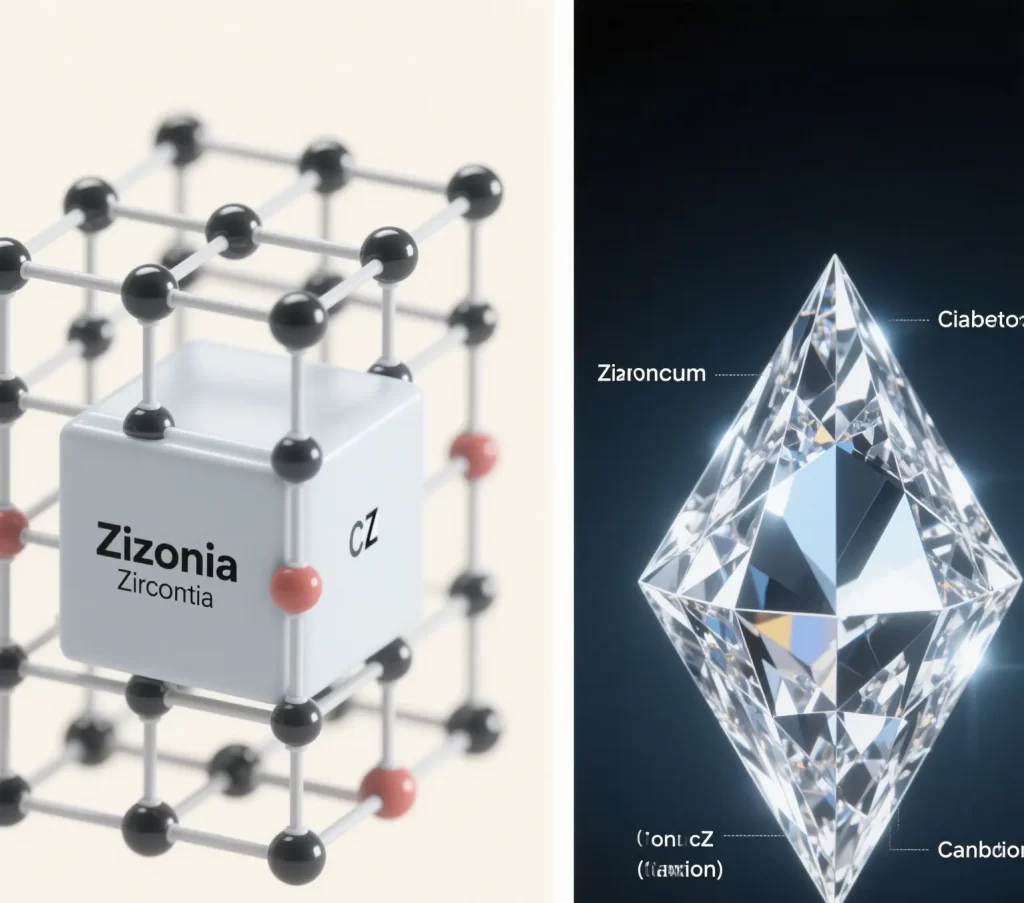
Cubic zirconia, commonly abbreviated as CZ, is a diamond simulant – a lab-created stone that mimics a diamond’s appearance but is not composed of carbon like natural diamonds. When jewelry is marked with ‘CZ,’ it specifically indicates the use of cubic zirconia stones rather than genuine diamonds. It may seem like a diamond, but it’s actually made with different materials and produced at a much lower cost. That makes it a popular choice for people looking for sparkly bling, minus the cost of natural diamonds.
CZ is now one of the most common gems in rings, earrings, and necklaces at jewelry stores across the U.S. Retailers typically advertise it as an intelligent and economical choice.
1. Defining Cubic Zirconia Chemically
CZ is constructed from zirconium oxide, rather than carbon as a natural diamond would be. This deceptively simple change imparts a distinct, appealing crystal form to CZ, which largely influences its aesthetic and tactile experience.
While diamonds are 100% carbon and have very dense, very strong carbon-carbon bonds, CZ forms a cubic structure. That latticework is what imparts CZ its brilliant, diamond-like sparkle. With the right tools, CZ can be easily distinguished from diamonds.
2. Understanding Its Lab-Grown Origin
The majority of CZ is produced in a laboratory. It is produced by subjecting zirconium oxide to high temperature and pressure, or through vapor in controlled environments. This new process is easier on mother nature than mining natural diamonds.
With the advancement of new technology over the years, CZ has become more defined and durable, allowing it to be greatly improved for extended use.
3. How CZ Differs From Zircon
CZ and zircon are similar in name, but the two gems are very different. Zircon, a natural gemstone with a chemical composition altogether different from CZ, typically displays more color and less brilliance.
CZ is much tougher than zircon, which makes CZ more practical for everyday jewelry. Both have a place in history, but CZ has taken over for the dramatic, sparkly appearances.
4. Key Properties: Sparkle and Hardness
CZ has a very pronounced sparkle because of its high refractive index of 2.20, nearly that of diamond. On the Mohs hardness scale, CZ rates 8–8.5 compared to diamond’s maximum hardness of 10.
These qualities allow CZ to stand up to wear and tear in rings and other jewelry designed for everyday use.
5. A Brief History Moment
CZ began appearing in jewelry by about 1976. Russian scientists improved the process, and ever since, it has found enthusiasts enchanted by its vivid appearance and economy.
HonHo Jewelry, a China-based maker, has used CZ for custom, waterproof, non-tarnish, and gold-filled pieces, showing how far CZ has come.
What CZ Markings Mean
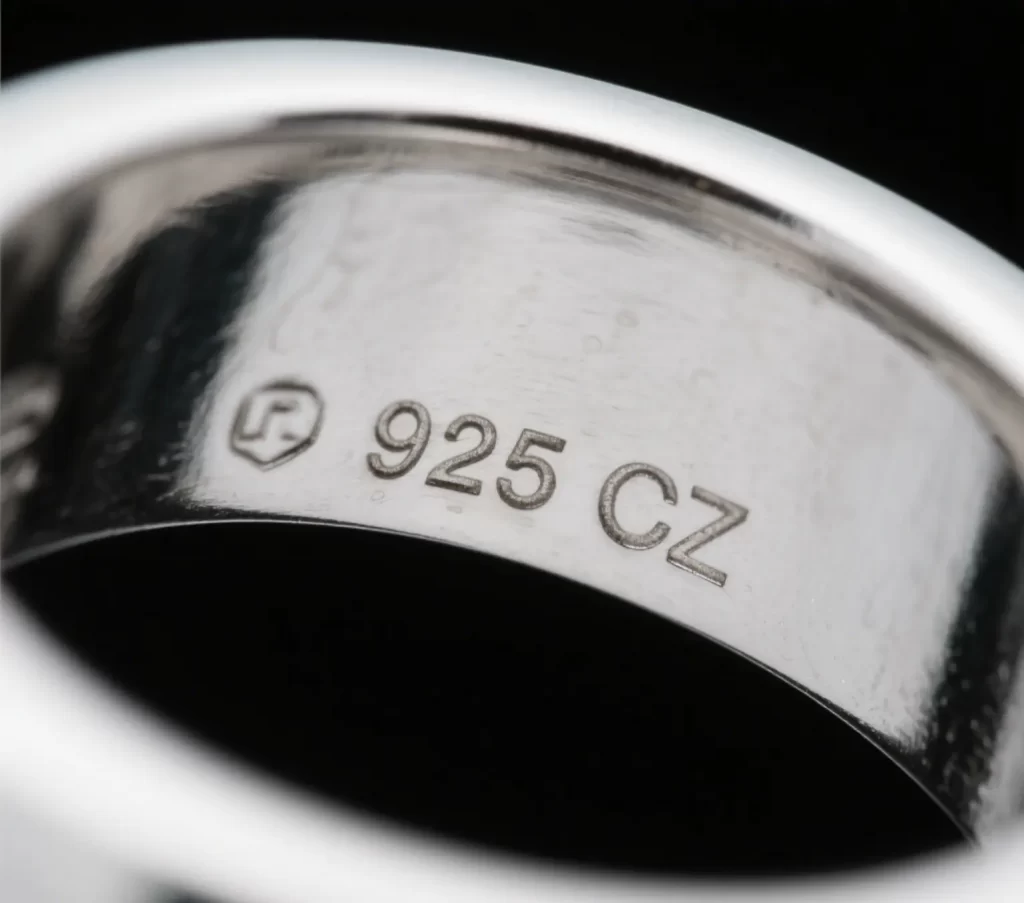
CZ jewelry markings are crucial identifiers that help consumers understand what their piece is made of. When you see ‘CZ’ or ‘925 CZ’ stamped on jewelry, these markings clearly indicate the composition of the piece. Many people search for ‘what CZ means in jewelry’ specifically to decode these important markings. These tiny hallmarks or engravings help consumers and jewelry collectors know if a stone is CZ. They tell you whether the metal is real silver or simply silver plated.
In the jewelry industry, a universal marking system allows consumers to easily check for quality. This is particularly important when it comes to identifying things that look like diamonds and avoiding them. Markings help you know if a piece is new or has a bit of history, like a reconditioned firearm or a vintage ring.
Identifying CZ Stamps on Jewelry
Identifying Cubic Zirconia (CZ) stamps on jewelry becomes straightforward once you know what to look for. Most CZ jewelry pieces will have ‘CZ’ or ‘C.Z.’ engraved on a discreet part of the item, such as inside the ring band or on the necklace clasp. Understanding these markings is essential for determining whether your jewelry contains CZ stones. Often, you will see a symbol in place of letters.
It might be a little square or a “b” with crossed swords, meaning that the item was inspected and passed. These markings go a long way in establishing buyer confidence that what you’re getting is what you expected.
HonHo Jewelry, a popular artisan from China, is very upfront with their stamping. That way, you’ll know instantly if it’s made out of stainless steel, brass, or 925 silver, and if the stone is CZ. This level of assurance is critical, particularly for consumers seeking waterproof or non-tarnish jewelry.
What “925 CZ” Tells You
When you see “925 CZ” on a ring or pendant, it means the piece uses sterling silver (92.5% silver) as the main metal and has a cubic zirconia stone set in it. This combination is what makes CZ a mainstay in fine but wallet-friendly jewelry.
The “925” part indicates the purity of the silver, while the “CZ” indicates that the stone is not a diamond. It’s an easy way to indicate the quality of metal and stone.
It’s Not a Diamond Stamp
CZ markings are often confused with diamond stamps. In real diamonds, you would see marks such as “D” or “Dia,” but for cubic zirconia jewelry, you would only see “CZ.
If you’re hoping to not purchase CZ when you intended to buy a diamond, make sure you check for these marks every time. Understanding the markings allows you to make the best informed decision, whether you are purchasing for yourself or someone else.
Why People Love CZ Jewelry
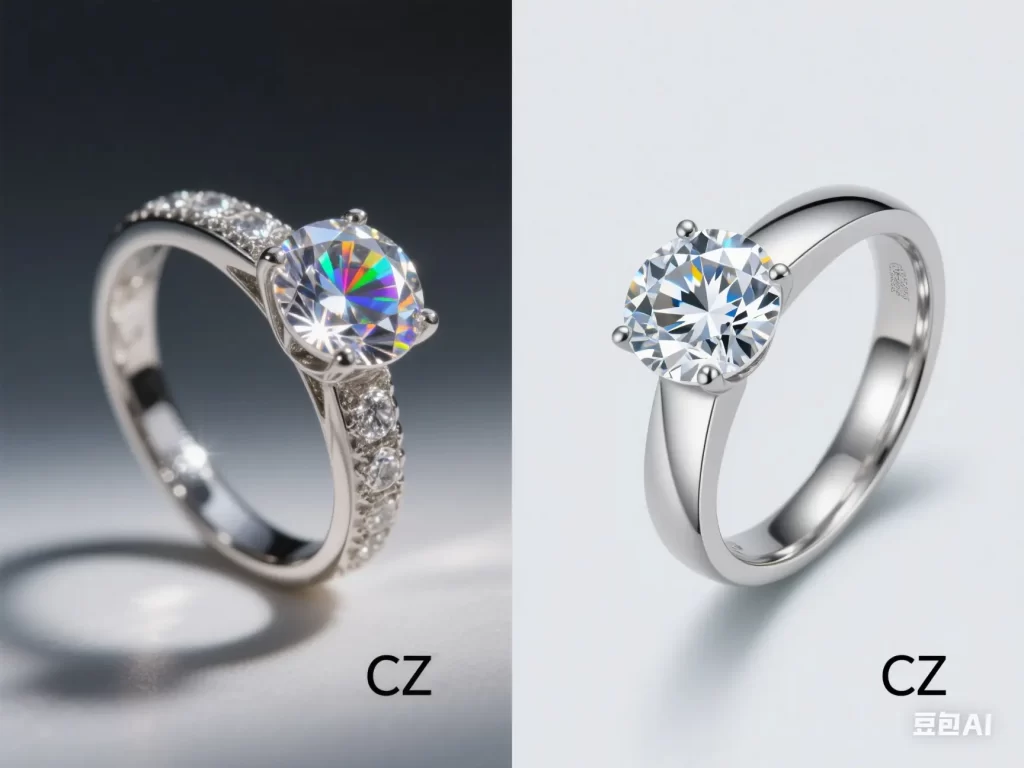
Today, CZ jewelry shines brighter than ever with its unbeatable combination of aesthetic, economic, and ethical appeal. It captures all of the beauty aesthetic wow found in diamond jewelry. It’s without the intimidating cost or ethical issues tied to mined gems.
CZ, or cubic zirconia, are lab created beauties. It can be made into a stunning statement piece, an everyday classic or anything in-between. With these qualities, it appeals to a wide range of consumers looking for a smart, edgy, and conscientious alternative.
Read on as we explain the top reasons why folks are returning again and again to CZ jewelry.
The Amazing Affordability Factor
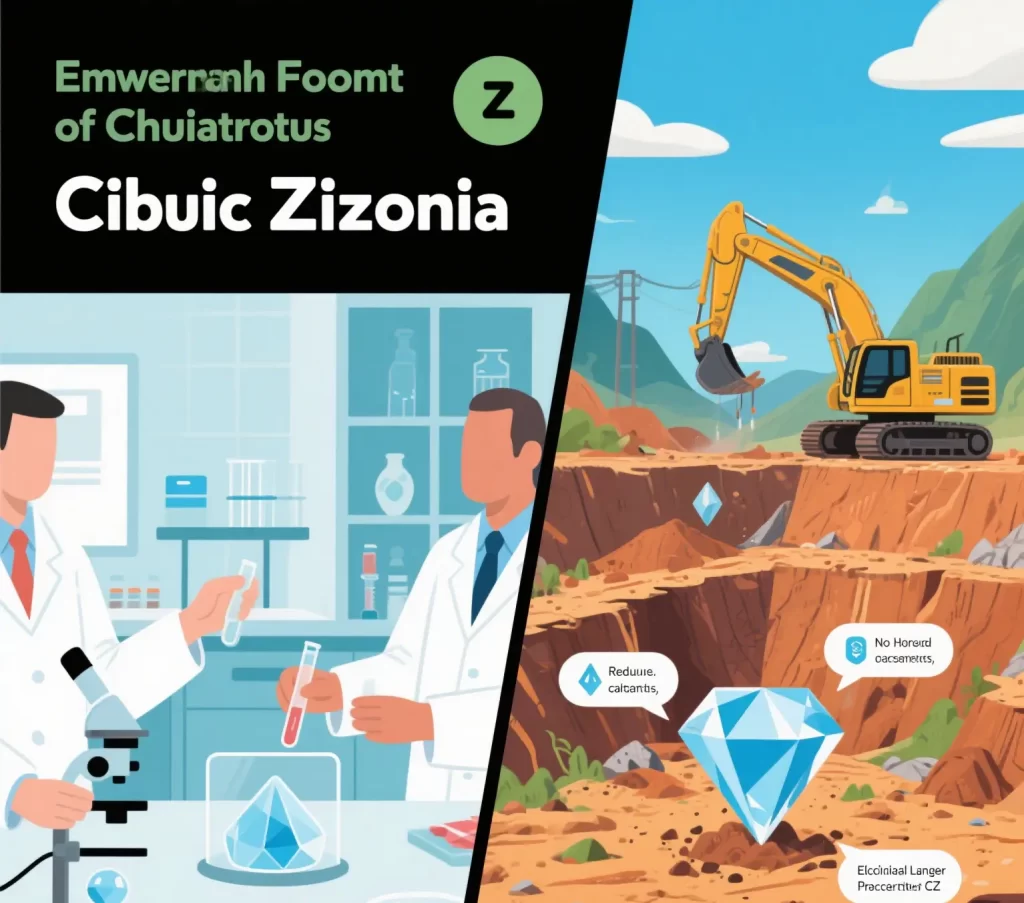
One of the most appealing aspects of CZ jewelry is its price. Your wallet will be the first to notice this one, as a typical CZ stone costs only 1/100th of what a natural diamond costs! It’s super easy to get a one-carat CZ engagement ring for less than $100.
By comparison, a diamond of the same size typically runs into the thousands. Since CZ is many times less expensive, shoppers can invest in larger stones or more intricate designs without breaking the bank. That leaves a lot of room for imaginative engagement ring styles and show-stopping statement pendant necklaces.
You’ll be able to play with big, bold statement earrings that were unaffordable with natural diamonds. It’s pretty darn easy to get your hands on CZ jewelry. That affordability factor opens the door to all kinds of shoppers, not just those spending high dollar amounts.
That huge availability means more consumers can experience exciting new styles and update their appearance. They can purchase jewelry for special occasions without fear of breaking the bank.
Looks Strikingly Like Diamonds
Perhaps the number one reason buyers adore cubic zirconia rings is how remarkably well they imitate the appearance of diamonds. Cubic zirconia stones have a refractive index of 2.088 – 2.176, which gives them lots of fire. Their dispersion rating, a measure of how light breaks into colors, is 0.058–0.066, nearly identical to that of a real diamond.
To the naked eye, CZ is usually indistinguishable from diamond in terms of sparkle. Beauty jewelers can cut CZ into just about every shape—round, princess, oval, cushion—as diamonds. That means consumers can choose from all the traditional cuts and styles they’ve come to expect and adore.
That’s why people who wear CZ jewelry are crazy about its magnificent sparkle. It looks amazing with casual and formal looks equally. CZ is available in a wide range of jewelry styles, from rings and earrings to bracelets and pendants. This versatility makes it all the more appealing.
Durable Enough for Daily Life
In addition to their stunning beauty, CZ jewelry is constructed to really withstand day-to-day use. On the Mohs hardness scale, which rates scratch resistance, CZ measures in at an 8.5. While it doesn’t match the 10 of a diamond, it still holds up well against most bumps, scrapes, and scratches.
Unlike other softer stones or metals, CZ isn’t going to rust, and it’s much more resistant to chipping under everyday wear. Whatever your reason for wearing jewelry, this stone is a smart choice for everyone.
It is durable enough to be worn every day and still continue to sparkle. That’s why so many people go with CZ when they want everyday rings, workwear or travel pieces—it’s just extremely durable. HonHo Jewelry is a China-based manufacturer with more than 15 years of experience.
For example, they’re making their jewelry waterproof and non-tarnish using stainless steel, brass, and 925 silver, enhancing their products with CZ for even greater durability.
An Ethical Jewelry Choice
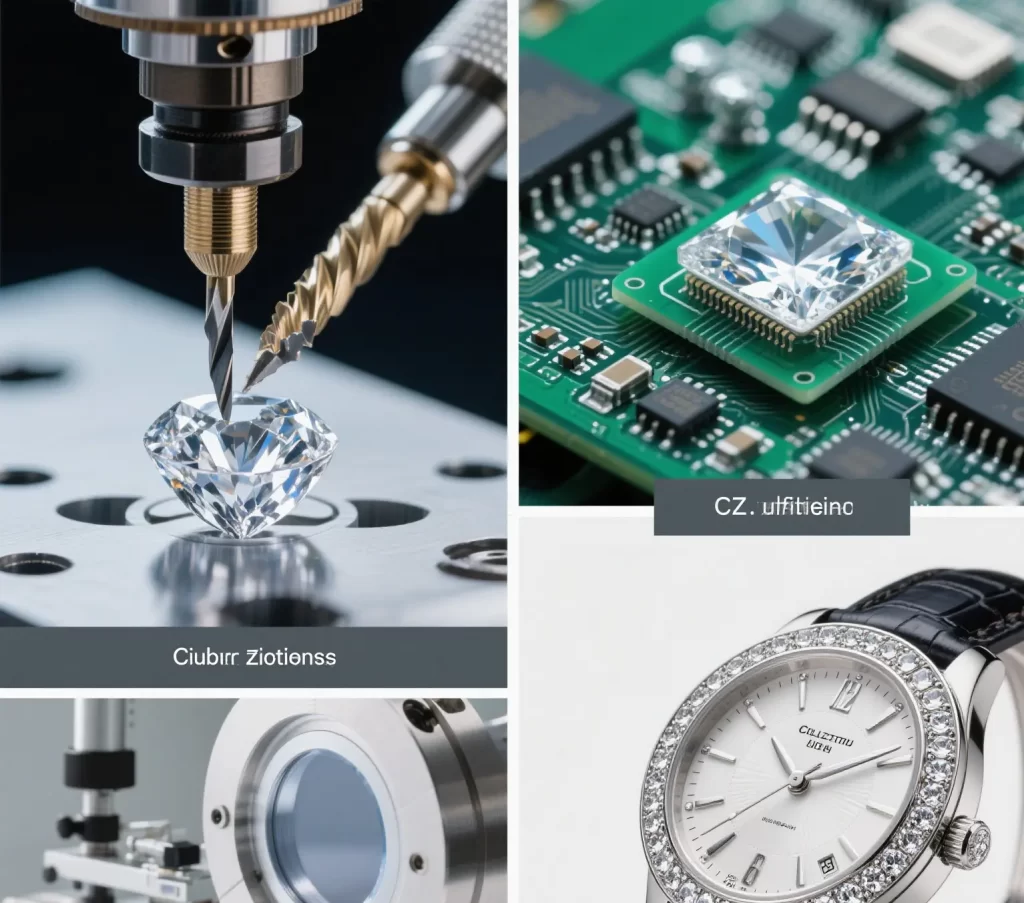
As buyers increasingly consider the origins of their products, CZ emerges as an ethical choice. Because it’s created in laboratories, there isn’t any potential for “conflict stones” or the ecological destruction associated with diamond mines.
This lab-grown, human-made process consumes less natural resources without the social and environmental costs prevalent in the mining industry. In doing so, more shoppers are realizing CZ is the perfect way to indulge in high-end jewelry with an ethical conscience.
The movement to shop ethically is powerful, and CZ is perfectly positioned within this movement. So everyone can wear it with pride, confident that it truly aligns with their values.
Wide Range of Colors Available
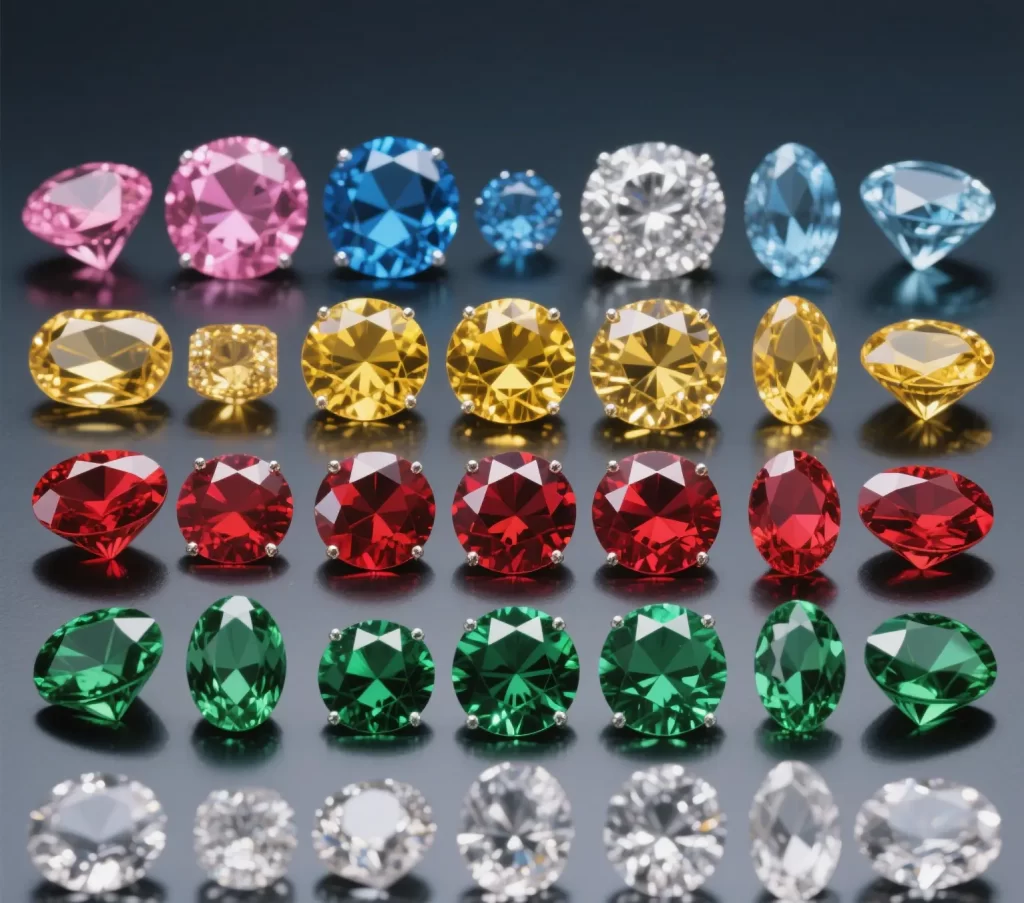
Lab-created CZ stones are available in a literal rainbow of colors. Pink, blue, yellow, red, green, and orange are all very popular choices. This extensive variety is feasible since the production process is regulated, allowing jewelers to form stones in just about every color.
For people who want something a little different, CZ is the perfect option. You’ll discover gorgeous possibilities such as pink engagement rings and blue pendants amongst them. This enables designers to create jewelry that appeals to every style, whether understated and timeless or strong and vibrant.
Great for Travel Jewelry
CZ jewelry is a great value for travel jewelry. Since it’s super affordable, there’s not as much risk if a piece goes missing or gets ruined while traveling. Its durable construction makes it able to withstand bumps and drops that may occur while traveling.
You can get CZ jewelry in any style and color you desire. This variety allows you to easily select pieces that match any look, whether you’re on a work trip or relaxing at the beach.
Travelers can comfortably pack light while still creating the versatility and options to dress up or down as needed.
Telling CZ from Diamonds Simply
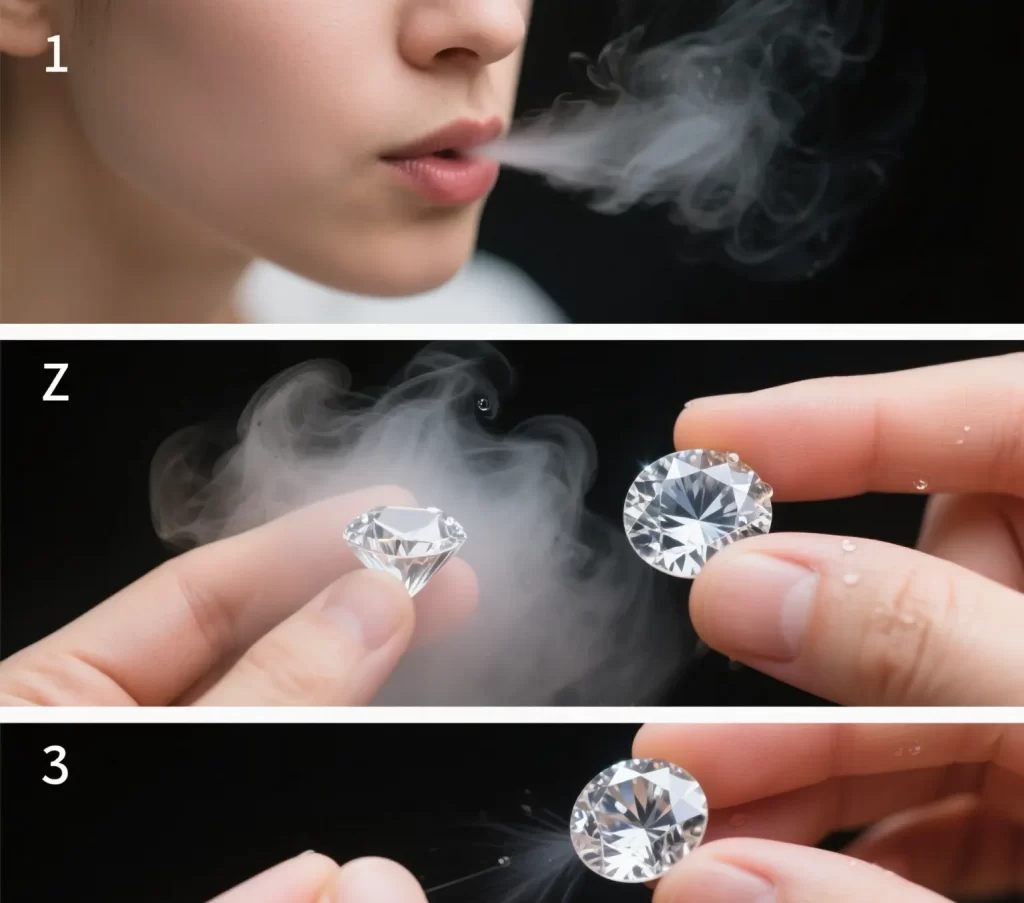
How to tell cubic zirconia rings (CZ) from diamonds is straightforward if you know the right techniques. Everyone will have questions about their jewelry, and a few intelligent quick checks can make a significant difference. Instead of relying solely on your eyes to assess the price and markings, you can discover the answers without needing special equipment.
Observe the Sparkle Difference
While diamonds and CZ are both sparkly, they sparkle in different ways. In direct sunlight, side by side, CZ tends to produce a “rainbow” effect. Diamonds sparkle with less white light, not more rainbow colors. This is due to the fact that diamonds have a higher refractive index, which results in a more crisp and bold glint.
Observe the sparkle difference Look closely for the crisp flashes found in diamonds compared to the more colorful light found in CZ. Through a jeweler’s loupe, you would be able to spot CZ’s neat, repetitive “fishnet” inclusions, whereas diamonds exhibit distinctive, organic structures.
Feel the Weight Variation
Feel the weight difference between the two easily identifiable stones. Diamonds are slightly heavier than CZ of the same size. The change might seem imperceptible, but it is profound.
Do both and feel if you can tell the weight difference. This simple tactile test is a great way to know for certain if you’re on the fence.
Consider the Obvious Price Gap
Since CZ is lab-created and far easier to manufacture, its price point is literally a fraction of a natural diamond. Consider the obvious price is often indicative of what you’re getting.
If it walks like a diamond and prices are too good to be true, chances are it’s CZ.
Check for Jewelry Markings
The vast majority of fine jewelry will have markings somewhere on it. Check for stamps or hand-written notes inside the band or clasp. These will often either identify CZ or state the type of metal, allowing you to verify what you have.
As with anything, always look for markings, especially when you’re considering a large purchase.
The Imperfect Fog Test
Slowly exhale onto the stone and watch the mist form. Diamonds are quick to clear, in a second or two. So CZ remains foggy for around 30 seconds.
Here’s a trick that’s pretty easy to pull off. This trick isn’t foolproof. Results may vary on humid days or if stones are dirty.
Keep Your CZ Sparkling
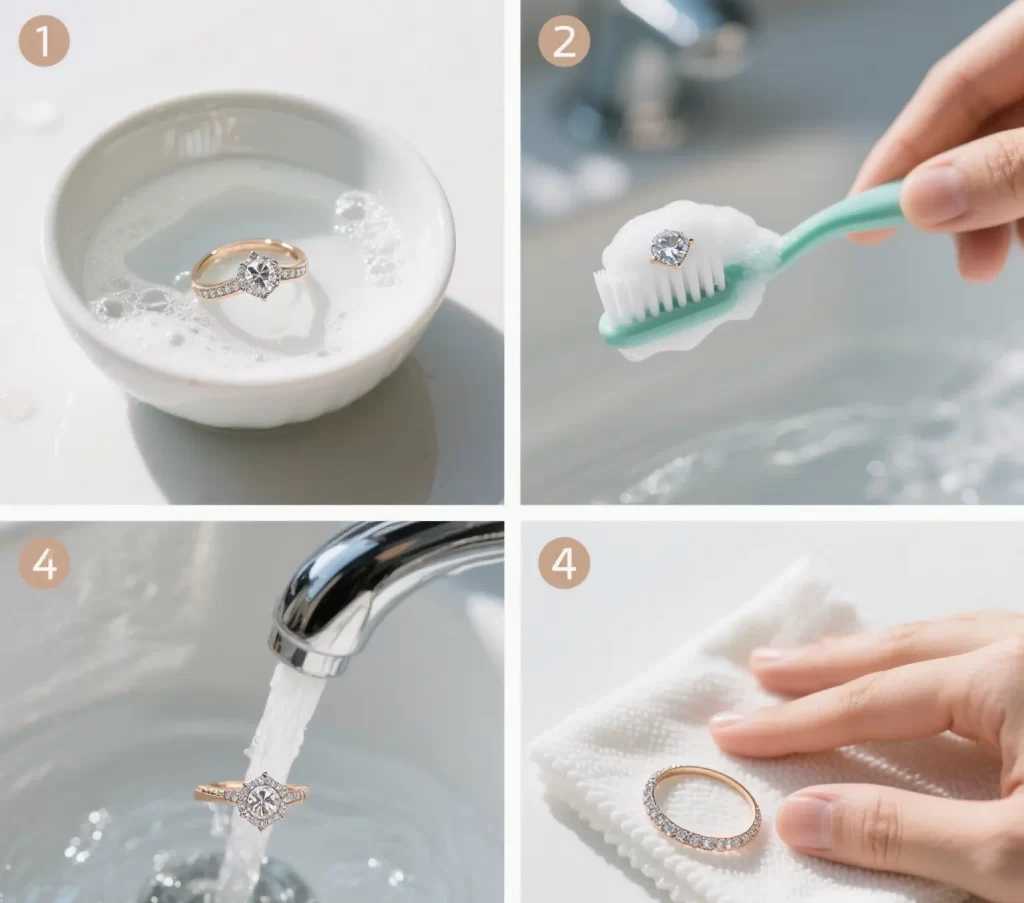
Cubic zirconia (CZ) jewelry sparkles with the intense fire of its colorless sparkle. It does need a little more TLC than diamonds to keep that gorgeous shine. Some simple maintenance goes a long way to ensuring your CZ adornments will last longer and remain as brilliant as the day you received them.
To protect the natural beauty of your CZ jewelry, store, clean and handle it properly. This is true for all jewelry, from basic diamond studs to statement making cocktail rings.
Simple Cleaning at Home
Home care for CZ jewelry is simple and requires just a few supplies. Combine a few drops of dish soap with warm water in a small bowl. Simply soak your CZ piece for a few minutes.
Next, take an old soft-bristle toothbrush to gently scrub around the stone and setting. Step 3—Rinse with clean water and pat dry with a lint-free cloth. Cleaning your CZ should be done every few weeks to remove oils from skin or wear that could make your CZ look cloudy.
Don’t use paper towels to clean your CZ; they will scratch it.
Chemicals to Definitely Avoid
Other cleaners are very damaging to CZ stones and the metal surrounding them. Avoid bleach, ammonia, acetone, or over-the-counter jewelry dips. Perfume, hairspray, and even hand sanitizer can as well, leaving a film or creating cloudiness.
Clean with mild soap and lukewarm water or a jewelry cleaner formulated for CZ. Take your jewelry off before applying makeup, lotion, and fragrance to reduce chemical exposure.
Smart Storage Protects Shine
Smart storage protects shine. How you store CZ jewelry can make a big difference. Store each piece in its own soft pouch or in a padded jewelry box to prevent scratching.
Flannel bags are ideal for this purpose. Keep it in a cool, dry place away from direct sunlight. Avoid throwing CZ items into a jewelry-filled drawer. Metals including 10K and 14K gold will scratch and dull the stones over time.
Is “CZ” Always Jewelry?
When the average person in the U.S. Hears “CZ,” they automatically think of cubic zirconia. This diamond substitute is super popular, they’re sold everywhere from the local mall kiosk to high-end department stores. It’s inexpensive, it sparkles, and it’s readily available.
Yet “CZ” extends far beyond jewelry. In the tech world, geography, and especially language, CZ is an abbreviation for other products.
Cubic zirconia was developed in a laboratory for use in the electronics industry. Today, it’s used not only in jewelry rings and earrings, but as industrial cutting tools and optical windows. Its hardness—about 8.5 on the Mohs scale—makes it durable, though not as durable as genuine diamond.
That’s why a CZ ring will likely scratch and lose its luster after a couple of years. The reality is that many people go for CZ because it’s an affordable alternative. From far away, it is nearly indistinguishable from a diamond.
You’ll find this pattern everywhere from your neighborhood to your big city. It’s not just the world of fine jewelry; think brooches, hair pins, and even some styles of watches.
The Czech Republic Connection (.cz)
You’ll recognize this as the closing for websites based out of there, such as “.cz.” It’s not a coincidence, as the Czech Republic has extensive history with fine glass and gem production. You would be hard pressed to find better glassmakers anywhere in Europe than in this small region.
Their artistry forges CZ gemstones and style, ushering in a vibrant heritage. It’s possible that local brands would take advantage of “CZ” to highlight their ties to Prague or other cities in the Czech Republic.
Other Meanings You Might See
Outside of stones, jewelry, and websites, “CZ” appears all over the place. It’s shorthand for other guns (such as CZ handguns), currency codes, and even airlines. This all gets really confusing quickly if you’re only considering jewelry.
That’s why context is everything—what “CZ” means is different based on where you’re encountering it.
Our View: Why CZ Rocks
Cubic zirconia (CZ) is known as a high-quality alternative to real diamonds, and for good reason. Its main advantage is the way it combines fashion, affordability, and quality. Anyone from a mechanic to a celebrity can find that CZ covers their specific wants and needs with its handsome appearance and affordability.
CZ buyers are increasingly choosing CZ, not only as the alternative to diamonds, but as the first-choice item and top budget picks.
Accessible Style for Everyone
CZ makes it possible for people who want to look great but don’t want or need to spend a fortune. You find CZ in just about everything—rings, earrings, bracelets, necklaces, and rings.
These stones are cut in various shapes including round, princess, or cushion so that everyone can enjoy a style that suits their taste. Companies such as HonHo Jewelry from China have started using CZ in stainless steel, brass, and 925 silver jewelry.
They produce sustainably made, waterproof, non-tarnish, and gold-filled jewelry, so style is truly accessible to everyone. This change aligns perfectly with the movement toward inclusivity in fashion—especially since now, anyone can feel special in what they wear.
Smart Bling Without Breaking Bank
CZ is easy on the wallet because it’s mass-produced and lab-created. Smart Bling Without Breaking Bank CZ is a fraction of the price of authentic diamonds, but still offers an ultra-luxe aesthetic.
Turns out a lot of people are looking for that smart bling without the heavy outlay. With CZ you get stones that are perfect.
These substantial beauties, 8.5 on the Mohs scale, are available in nearly every diamond configuration you can dream of. CZ is still softer compared to diamonds and can become cloudy after decades of wearing.
For the majority, the value far outweighs the trade-off.
Celebrating Beauty in Many Forms
CZ is most famous for its sparkling brilliance and precise faceting. Its weight—75% heavier than a diamond of equal size—adds to its sumptuous appearance.
Artists are drawn to CZ because of its variety of colors and simple manipulation, allowing them to create both traditional and contemporary designs. This allows consumers to choose what highlights their own unique aesthetic.
Conclusion

CZ, or cubic zirconia, is a man-made stone that is nearly identical to diamond in appearance but is far less expensive. People love CZ because it sparkles, it’s durable, and it’s easy on the pocketbook. People wear it in jewelry, such as rings, earrings, and even smartwatches. CZ can be identified by its heavier weight, greater clarity, and much lower price tag than diamonds.
Cubic Zirconia (CZ) jewelry offers an accessible way to enjoy the beauty of diamond-like stones without the premium price tag. Whether you’re looking for everyday accessories or special occasion pieces, understanding what CZ means in jewelry context helps you make informed choices about your purchases. With proper care, your CZ jewelry can maintain its brilliant sparkle for years to come, making it both a practical and beautiful alternative to diamond jewelry.
Frequently Asked Questions
What does “CZ” stand for in jewelry?
When used in jewelry, CZ stands for cubic zirconia stones. This popular diamond alternative is a lab-created gem that mimics the appearance of a real diamond but comes at a fraction of the cost.
How can you tell CZ apart from real diamonds?
Cubic zirconia stones are denser than diamonds, exhibiting a stronger rainbow sparkle when light hits them. The good news is that most jewelers can tell the difference with a simple tool.
Is cubic zirconia safe for sensitive skin?
So, cubic zirconia stones are hypoallergenic. If you have sensitive skin, always check the metal setting to ensure it’s nickel-free.
Does CZ jewelry lose its sparkle over time?
Cubic zirconia stones only lose their sparkle if they become dulled by dirt, and with regular delicate cleaning, they’ll maintain their original brilliance.
Can CZ be used in engagement rings?
Yes, indeed! There are many good reasons why people choose cubic zirconia rings for engagement rings. Beautiful, affordable, and durable are just a few.
Is “CZ” only used in jewelry?
No, cubic zirconia stones can be used in lasers, optics, and electronics, but jewelry is where it’s gained the most popularity.
Why is CZ jewelry so popular in the U.S.?
CZ jewelry, featuring stunning cubic zirconia rings, is popular for its diamond-like appearance. These CZ pieces offer affordability without sacrificing brilliance. Cubic zirconia jewelry comes in diverse designs, from classic CZ solitaires to elaborate settings, making it versatile for both casual and formal wear.
What does CZ mean when marked on jewelry?
When you see ‘CZ’ marked on jewelry, it specifically indicates that the piece contains Cubic Zirconia stones rather than natural diamonds or other gemstones. This marking is a standard industry practice to clearly identify the materials used in the piece, helping consumers make informed purchasing decisions.
share this recipe:
Still hungry? Here’s more

Gold Filled vs Vermeil Guide Differences Durability and Value
What Is Gold Filled Jewelry? Gold filled jewelry is my go-to recommendation when someone wants

How Much for a Gold Necklace 2026 Price Guide and Tips
Understanding Gold Purity and Karats When people ask “how much for a gold necklace?”, the

Spiritual Jewelry Symbols Guide- Meanings and How to Choose
How to Use This Spiritual Jewelry Symbols Guide Spiritual jewelry only works for you when
Ready to Design Your Own Jewelry?
Have an idea in mind or need help shaping it? From sketches to finished pieces, our custom jewelry team will work with you step-by-step to bring your vision to life.
